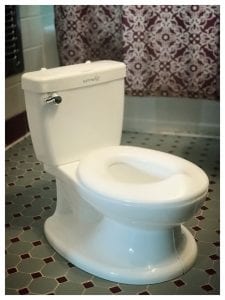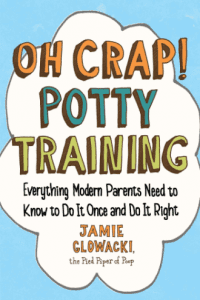When my daughter first showed interest in the potty, we bought a tiny little potty that looked exactly like a toilet, complete with flush handle and recorded flushing sound. (Warning: as cute as it is, it is just as hard to clean as a regular size toilet and the novelty of the flushing sound wears off). I knew I wanted my daughter to see that using the toilet is simply a part of everyday life, so I began putting her on the potty at set times: upon waking, before and after meals, before leaving the house, and before sleep. 
When she was a bit older, we did a day of minimal clothing and I followed her around everywhere, prompting her to use the potty every 30-45 minutes. She had an accident that morning and I said, “You peed on the floor, pee goes in the potty,” making sure to be calm and not show any frustration. The next day, I put her in regular clothes. I avoided panties, diapers, or pull-ups and just let her wear pants, continuing to prompt her based on my observations.
For about a month, we went on like this with occasional accidents which were decreasing in volume every day. As for the dreaded “Number 2,” she had a few accidents at the beginning, but she didn’t like the mess and opted for the potty every time. After a little while, she went from noticing she had peed to telling me she had peed and eventually (and we’re still working on this one)
to telling me she needed to pee.
We eventually started using panties at home which she joyously referred to as “tanties.” During outings, she wore panties with a pull-up over it or a cloth diaper. I liked for her to feel the wetness but I can imagine cleaning up a mess in the freezer aisle at Trader Joe’s and it doesn’t look pretty. We still took her to the potty when we were out and more often than not, she stayed dry. Once she was able to hold it longer, we left the pull-ups behind and haven’t looked back…during waking hours that is.
As for sleeping, I have read the best way to begin is to wake her “slightly” (ha!) to pee several times during the night and then to eventually pare down the times as her ability to hold it grows. Perhaps the author of one of the potty training books I read would like to volunteer for the night training.
The nitty gritty:
1. Be sure your child is ready.
Common readiness signs include:
-Pulling at a wet or dirty diaper
-Staying dry for longer periods of time
-Hiding when pottying in their diaper
-Telling you when they need a new diaper
-Able to pull down pants
-Understands bathroom verbiage
-Interest in the potty
2. Be sure you’re ready.
I didn’t quite realize the commitment I was making, but once I started, I felt I had to press on. It would be confusing and frustrating to begin and THEN realize you aren’t quite ready.
3. Decide on a potty.
The goal is self-reliance. Will they be comfortable sitting on the big potty and able to do it on their own? If not, consider getting a smaller one. But don’t forget, they will be using a big toilet when you are out in public, so they might need a little balancing practice either way…unless you wanna bring a potty seat with you everywhere.
4. Consider a method.
I really enjoyed the book, “Oh Crap Potty Training” but there are about as many books and methods of potty training as there are types of little tiny toilets…and maybe more. No matter what you choose, a little research goes a long way.
5. Take the plunge.
Pun intended. Eventually, and probably sooner than later, you are going to have to go for it. You deserve to have freedom from diapers, of course, but so does your little one. Give them the gift of dignity and independence. It will be work, but chances are you won’t regret it.
6. Remember: Accidents happen.
Don’t sweat it if your child has accidents. They can read the frustration on your face which won’t help the process one bit. Accidents are a part of life and sometimes the best way to learn something new is through a little trial and error – which is what parenting is all about!
KDCDC Note: It is crucial to make sure you are on the same page with your child’s other caregivers when it comes to potty training. If you are co-parenting, have a nanny/babysitter, or your child attends daycare, be sure and let other caregivers know that you are beginning potty training and which method you are using. And if you are unsure whether your child is ready, chances are, their other caregivers have some insight to share as well.
For more information about developmental milestones or to donate to our non-profit child development center, visit www.kdchild.org.
Written by Erin Hall, Grants Manager
2 Comments
Ms. vesta · September 19, 2019 at 6:46 pm
great blog Erin!
Callie Hendrickson · September 23, 2019 at 9:00 am
Thank you for reading!